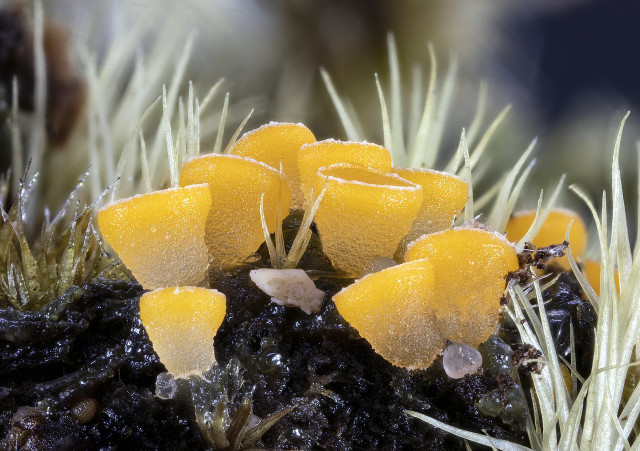Mushroom mycelium is becoming better understood within scientific and environmentalist communities for its impressive sustainable capabilities. Read on to find out what they are.
Mushroom mycelium, the fungal network of fine white filaments called hyphae, is the root-like structure from which mushrooms grow. The web-like mycelia grow in soil or above ground on other substances. While not all mycelia fruit — or produce — mushrooms, all mushrooms come from mycelia.
Mushroom mycelium generally grows in forests, fields and other wooded areas. Some mycelia can expand to cover thousands of acres and others are microscopic. Mycelia thrive on a vast range of materials, so while they exist naturally in the wilderness, they are also found in commercial settings where our understanding of their benefits is just beginning to emerge.
Mycelium is a sustainable and renewable resource because it can be recycled and regrown over and over again. Furthermore, as a member of the fungi kingdom, it breaks down just like other organic matter.
With industries searching for new and innovative approaches to sustainability, mushroom mycelium is increasingly popular, and for good reason. Here are the seven sustainable superpowers of mushroom mycelium.
1. Mycoremediation

(Foto: CC0 / Pixabay / 557453)
Many fungal mycelia, such as white-rot fungi, contain powerful extracellular enzymes and acids capable of breaking down organic molecules. This adaptation, called mycoremediation, can be used to break down materials that aren’t otherwise biodegradable, such as plastics and unrefined oils.
2. Sustainable Materials



(Foto: CC0 / Pixabay / Illuvis)
Mushroom mycelium can be engineered to create new materials with a broad range of applications. For example, a new building material called mycelium compound is breaking ground as a low-carbon, fire-resistant and termite-deterring substance.
3. Mylo™ Material



(Foto: CC0 / Pixabay / jggrz)
In the fashion industry, mycelium is being used to create a cruelty-free material similar to leather, called Mylo™ material. This versatile material can be dyed, tanned and used to produce items typically made from leather, like jackets, wallets, handbags and footwear.
4. Mycelium and Biofuels



(Foto: CC0 / Pixabay / Hans5Luiten)
Producing biofuels from food crops can be costly and competes with food production’s access to land, water, energy and other resources. However, a 2018 study discovered a strain of fungi that appears highly effective at producing cellulosic biofuel — specifically cellulosic butanol.
Previously, it was thought that there were only a limited number of these microbes capable of converting biomass into biofuel. This new understanding of mycelia expands the potential for sustainable energy to eventually reduce our dependence on fossil fuels.
5. Mycelium as Packaging Material



(Foto: CC0 / Pixabay / simonproulx)
The same technology used to create sustainable building material from mushroom mycelium is also being used to create packaging. This technology is already being used by companies such as Dell and Ikea.
To make this material, mycelium is grown over organic farm waste to create a solid shape and then dried to stop the mycelium from growing further. It’s simple and most importantly, biodegradable.
6. Forest Health and Mycorrhizal Symbioses



(Foto: CC0 / Pixabay / Bertsz)
Old-growth forests are vital to the health of our planet for many reasons. They harbor significant amounts of atmospheric CO2, create oxygen, and they contribute to clean, quality air. Furthermore, they develop microclimates that cannot be matched. Furthermore, they encourage biodiversity. These benefits contrast sharply with those of mono-forests or young forests.
Mono-forests on the other hand are forests in which more than 60% of the tree canopy consists of a single species. These types of forests are increasingly common as reforestation projects are becoming more important in reaction to climate change. These types of forests are often dangerous because, many times trees that are easier and faster to grow, such as eucalyptus and acacia, are chosen because they can be cut down quickly in order to make pulp for paper. The cut trees then release carbon into the atmosphere and can also lead to decreases in biodiversity.
Mushroom mycelia are vital to the ecosystems of forests and old-growth forests. These fungal networks connect the soil, tree roots, and other plants in the soil through the web of mycelia. The fungi mycelia send messages, nutrients, and carbohydrates among the plant life of the soil. The fungi also help protect the trees from pollutants because they absorb heavy metals from the soil. The mycelia in return transfer water and nutrients to the roots of the tree and other plant life in the soil. This beneficial, mutual relationship between mushroom mycelia, trees and plants is known as mycorrhizal symbiosis. Within old growth forests, mushrooms mycelium further maintain symbiosis, help decompose “dead woody tissue,” and help against parasites.
7. Mycelium and Soil



(Foto: CC0 / Pixabay / adege)
Another known superpower of mushroom mycelium is its effectiveness at improving and restoring soil polluted by oil and gasoline more efficiently than conventional methods.
It’s estimated that fewer than 7% of the estimated 1.5 million species of mushrooms have been identified. With scientists regularly uncovering new superpowers of mushroom mycelium, the potential for discovery is exciting.
Read more:
- Want to Ferment Mushrooms? It Can be Done, Here’s How!
- How to Dry Mushrooms in the Oven, Dehydrator, or Naturally
- How to Ferment Vegetables: A Beginner’s Guide
Do you like this post?









